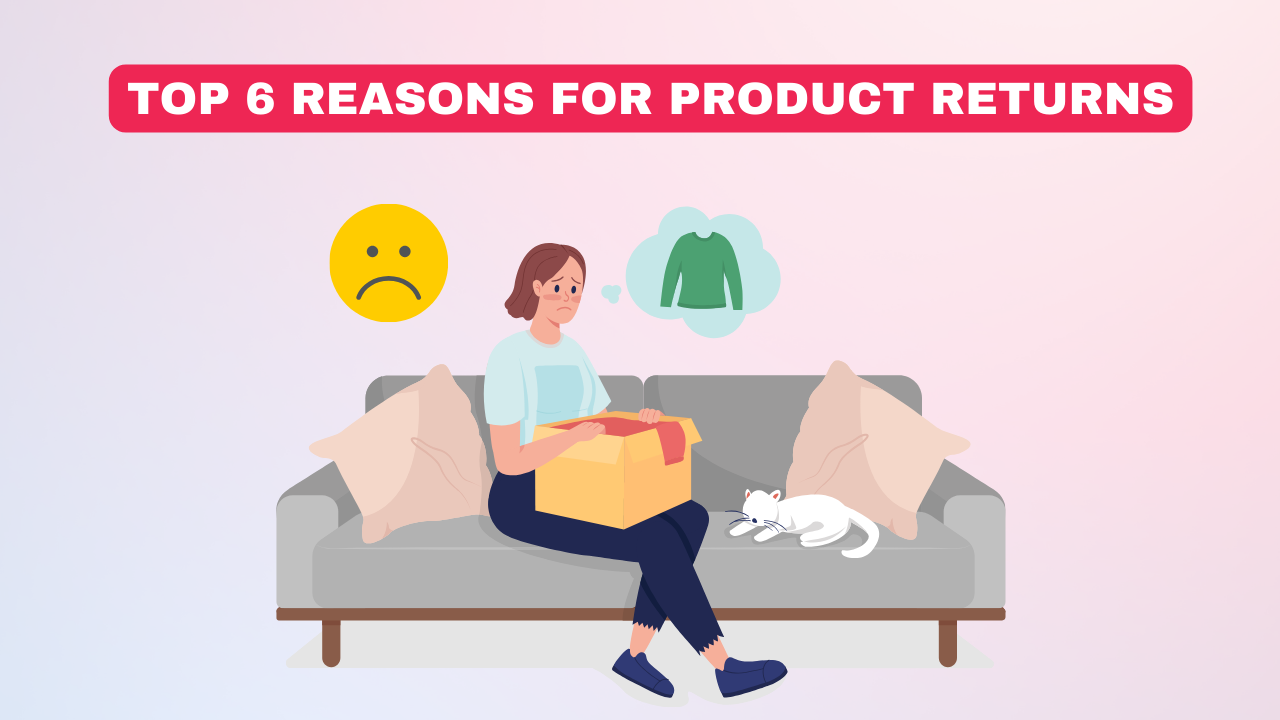The e-commerce world is full of opportunities, but one big challenge is dealing with product returns. On average, 20% to 30% of items bought online end up being sent back, often due to things like wrong sizes or product descriptions not matching reality. This can be tough for business owners, leading to increased costs and prices.
In 2020, around 600 million products were returned globally, causing stress for retailers. E-commerce return rates are expected to grow by $1.4 Trillion by 2025. To tackle this issue, we\’ll explore 10 practical ways to reduce e-commerce returns and improve the overall customer experience.
Top 6 Reasons Why Customers Return Products

Before we dive into how to reduce product returns, let’s understand why they’re being returned in the first place. Here are the top 6 reasons why customers return a product:
- Not Happy with the Product: Sometimes, customers return items because they\’re not happy with how they work or how they\’re made.
- Size Problems: Clothes and shoes can be returned if they don\’t fit right, for example, if the clothes are too small or the shoes are uncomfortable.
- Product Doesn\’t Match the Description: If what customers see online doesn\’t match what they get in real life, they might return the item.
- Broken or Not Working: Items that arrive damaged or don\’t work properly are often sent back because customers want things in good condition.
- Changed Mind: People might change their minds about a purchase or regret buying something, so they return it.
- Late Delivery: If an item arrives after the expected date, customers may return it, especially if they needed it urgently.
Now that we know the root of the problem, let’s look at the ways to solve it. By implementing effective strategies, you can transform return challenges into chances for growth and enhancement. Now, let\’s delve into these strategies!
10 Strategies to Reducing eCommerce Product Returns
1. Detailed Product Descriptions
It\’s crucial to offer customers detailed and accurate product information. This includes everything from dimensions and materials to features and functionalities. The goal is to provide customers with all the necessary details so they can make an informed decision and minimize the chances of dissatisfaction upon receipt.
2. High-Quality Product Images
Visual representation plays a significant role in online shopping. Providing high-quality images from various angles gives customers a clear and realistic view of the product. This helps set accurate expectations and reduces the likelihood of returns due to discrepancies between the product received and what was expected.
3. Size Guides and Measurements
Fit issues are a common reason for returns, especially in the apparel and footwear categories. Including size charts and detailed measurements helps customers choose the right size with confidence, ultimately minimizing returns associated with sizing issues.
4. Customer Reviews and Ratings
Customer feedback is invaluable in the online shopping journey. Encouraging previous buyers to leave reviews and ratings provides social proof and insights to potential customers. This helps set realistic expectations and builds trust, reducing the likelihood of returns due to mismatched expectations.
5. Virtual Try-on Tools
For products like clothing, eyewear, or accessories, offering virtual try-on tools allows customers to visualize how the items will look on them before making a purchase. This interactive feature enhances the online shopping experience and reduces uncertainty, leading to fewer returns.
6. Interactive Product Videos
Interactive product videos go beyond static images by showcasing the product in action. These videos highlight features, benefits, and real-life usage scenarios, helping customers better understand the product and its value proposition. This can lead to more confident purchase decisions and fewer returns due to misunderstandings.
7. Hassle-Free Return Policy
A transparent and easy-to-understand return policy is essential for building customer trust and confidence. Offering free returns or exchanges within a reasonable timeframe removes barriers to purchasing and provides peace of mind to customers. This reduces hesitancy and increases the likelihood of conversions while minimizing the impact of product returns on profitability.
8. Personalized Recommendations
Leveraging customer data to provide personalized product recommendations enhances the shopping experience. By analyzing past purchases and browsing history, businesses can offer relevant suggestions tailored to each customer\’s preferences and needs. This increases the likelihood of customer satisfaction and reduces returns by guiding customers towards products they\’re more likely to love.
9. Proactive Customer Support
Responsive and proactive customer support is crucial for addressing any pre- or post-purchase (from product inquiries to shipping and returns) queries and concerns. Offering multiple channels of communication, such as live chat, email, or phone support, ensures that customers can reach out for assistance whenever they need it. Promptly addressing issues and aiding can prevent potential product returns by resolving problems before they escalate.
10. Continuous Improvement
Analyzing return data allows businesses to identify trends and patterns that can inform product improvements and customer experience enhancements. Product returns management software such as EcoReturns provide in-depth analytics of returns and help pinpoint the issues to act upon. By regularly reviewing product returns reasons and customer feedback, businesses can proactively address common issues and refine their product offerings. This iterative process of continuous improvement helps minimize returns and optimize the overall shopping experience for customers.
In summary, effective management of product returns is crucial for e-commerce success. By addressing common reasons for returns and implementing proactive strategies like improving product descriptions and offering flexible return policies, businesses can reduce return rates, boost customer satisfaction, and foster growth. Prioritizing the customer experience and leveraging data-driven insights are key to thriving in a competitive market and building strong customer relationships.


